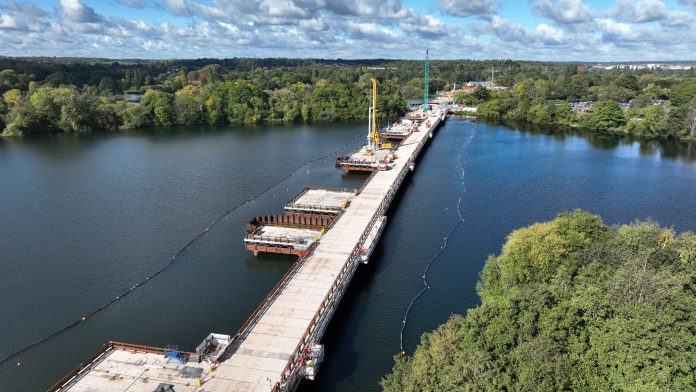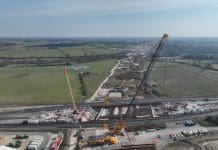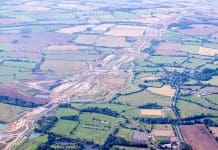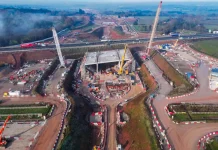The 2.1 mile (3.4km) Colne Valley Viaduct will be 100m longer than Dundee’s Tay Bridge, which currently holds the title
The last of 292 concrete piles that will form the foundations for the UK’s longest railway bridge have been installed at the HS2’s Colne Valley Viaduct site.
The viaduct is being built by HS2 Ltd’s main works contractor Align JV – a team made up of Bouygues Travaux Publics, Sir Robert McAlpine, and VolkerFitzpatrick, working with its contractor KVJV– who spent almost two years on the piling.
KVJV is a team made up of Keller Group and VSL International.
Environmental considerations were part of the project from the start
HS2 worked closely with Affinity Water and the Environment Agency to monitor water quality and agree working methods.
These were monitored by a team of specialist engineers during construction in order to protect the natural environment.
Before work began, an extensive programme of test piling was completed with engineers sinking 12 piles at two locations with geological and structural data from these tests fed back into the design of the Colne Valley Viaduct.
This resulted in a 10-15% reduction in the depth of the piles and associated time and cost savings.
The widest spans are reserved for where the viaduct crosses the lakes, and narrower spans for the approaches. This design was chosen to enable views across the landscape, minimise the viaduct’s footprint on the lakes and help complement the natural surroundings.
Once complete, the 2.1 miles (3.4km) bridge will carry the new high-speed rail line across a series of lakes and waterways near Hillingdon on the north-west outskirts of London.
Offsite construction has been used for swifter project delivery
The construction of the foundations, the 56 huge piers and the deck on top, have all been happening in parallel – with separate teams working from north to south. Deck assembly began last year, with more than 500 meters of the Colne Valley Viaduct viaduct structure now complete.
In order to deliver the 66 piles in the lakebed, the team first had to construct over a kilometer of temporary jetties, with cofferdams to hold back the water around each set of foundations.
The jetties are also used to transport materials and equipment during the construction of the piers and viaduct deck, keeping vehicles off local roads.
On top of each group of piles – some of which are to a depth of 60m into the ground – a concrete pile cap will support the pier which will in turn support the weight of the bridge structure above. Instead of hammering the piles into the ground, holes were bored before being backfilled to create the piles.
The main deck of the Colne Valley Viaduct is being built in 1,000 separate segments at a temporary factory nearby and assembled using a bridge-building machine which lifts each piece into position before shifting itself forward to the next pier.
The Colne Valley Viaduct foundations were delivered with minimal impact on the environment
HS2 Ltd’s project client, David Emms said:
“The completion of the piling for the Colne Valley Viaduct is a major achievement for our whole team and marks the end of almost two years of hard work. With pier construction and deck assembly also well underway, the viaduct is fast becoming one of the most impressive and recognisable parts of the project.”
Align’s surface operations director, Derek van Rensburg said:
“Completing the piling is a great achievement for both Align and the team at KVJV, working over the lakes and waterways across the Colne Valley. We were able to complete the piling with no significant impact on the environment, a great result for the whole team.”












![[VIDEO] First HS2 twin-bore tunnel completes civil engineering phase The HS2 twin bore tunnel, Long Itchington Wood Tunnel](https://www.pbctoday.co.uk/news/wp-content/uploads/2025/02/HS2-Long-Itchington-tunnel-walk-25_cropped-218x150.jpg)

![[VIDEO] HS2 Small Dean viaduct slid into position in just four days Aerial view of the Small Dean viaduct being assembled by the A413](https://www.pbctoday.co.uk/news/wp-content/uploads/2025/02/Aerial-view-of-Small-Dean-viaduct-deck-assembled-alongside-the-A413-before-its-launch-Jan-2025-218x150.jpg)
